食品科学投稿格式
foodchemistry格式要求
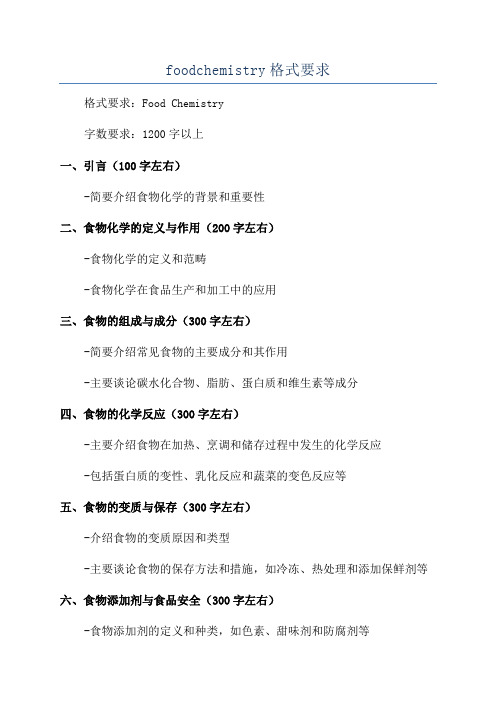
foodchemistry格式要求
格式要求:Food Chemistry
字数要求:1200字以上
一、引言(100字左右)
-简要介绍食物化学的背景和重要性
二、食物化学的定义与作用(200字左右)
-食物化学的定义和范畴
-食物化学在食品生产和加工中的应用
三、食物的组成与成分(300字左右)
-简要介绍常见食物的主要成分和其作用
-主要谈论碳水化合物、脂肪、蛋白质和维生素等成分
四、食物的化学反应(300字左右)
-主要介绍食物在加热、烹调和储存过程中发生的化学反应
-包括蛋白质的变性、乳化反应和蔬菜的变色反应等
五、食物的变质与保存(300字左右)
-介绍食物的变质原因和类型
-主要谈论食物的保存方法和措施,如冷冻、热处理和添加保鲜剂等六、食物添加剂与食品安全(300字左右)
-食物添加剂的定义和种类,如色素、甜味剂和防腐剂等
-谈论食物添加剂的安全性和监管措施
七、结论(100字左右)
-简要总结食物化学的重要性和应用
-强调食品安全的重要性
-列举所参考的相关文献,包括学术期刊、教科书和专业报告等
请根据以上要求完成一篇长度不少于1200字的食物化学的文章。
食品科学杂志写作格式

《食品科学》投稿写作模板模板使用方法:1.在Windows操作系统中,直接双击本模板文件,作者可以输入稿件。
如果作者想将稿件直接输入模板中,请选中你想代替的文字,然后开始输入稿件内容(例如,选中“标题”部分输入你自己的标题)。
2.投稿时请使用通栏,不必分两栏,分栏工作由排版人员完成。
3. 如果已有稿件Word文档,则可以拷贝、粘贴稿件内容到本模板。
4. 请确认稿件内容格式无误后,删除所有不需要的部分,包括说明部分(红色字体部分)和修改痕迹。
5. 保存文件:选择“文件→另存为”为Word文档文件(.doc)。
总则:1. 文中所有的中文都使用“宋体”字体;所有的的英文和数字都使用“Times New Roman”字体,包括标题、图、表、参考文献等。
2. 中英文表述中,数值和单位之间间隔1/4中文字宽度的空格。
3.具体写作要求参考投稿须知,格式要求见下文。
题目宋体小一、居中、加粗、无缩略语第一作者姓名1,作者二姓名2,通信作者姓名1,*(宋,10.5号,如果第一作者不是联系人,请在通信联系人右上角标注*;两个字的作者名字间空一格;外籍作者用英文全名,不能缩写,并尊重该国姓名表达习惯,少数民族作者姓名按其民族习惯著录姓名。
不同工作单位的作者姓名右上角加注数字序号。
如果所有的作者都在同一个单位,则不需对作者编号。
)(1.作者单位正式对外名称,省份城市邮编;2.作者单位正式对外名称,省份城市邮编)宋体9号(作者的工作单位,均应包括单位全称(大学原则上标注到具体的学院)、所在省市名及邮政编码,单位名称与省市之间应以逗号“,”分隔,整个单位信息项用圆括号“( )”括起。
多作者的工作单位名称之前加与作者姓名序号相同的数字序号,单位编号应按在文中的出现顺序依次排号,各工作单位之间连排时以分号“;”分隔。
)摘要:宋体9号,摘要中首次出现的英文缩写名,不能直接用英文缩写形式,需用“中文名(英文全名,点击03版WORD的“插入”或07版WORD的“引用”工具,用其中的“插入脚注”按钮插入短横线。
食品科学杂志写作格式

《食品科学》投稿写作模板模板使用方法:1.在Windows操作系统中,直接双击本模板文件,作者可以输入稿件。
如果作者想将稿件直接输入模板中,请选中你想代替的文字,然后开始输入稿件内容(例如,选中“标题”部分输入你自己的标题)。
2.投稿时请使用通栏,不必分两栏,分栏工作由排版人员完成。
3. 如果已有稿件Word文档,则可以拷贝、粘贴稿件内容到本模板。
4. 请确认稿件内容格式无误后,删除所有不需要的部分,包括说明部分(红色字体部分)和修改痕迹。
5. 保存文件:选择“文件→另存为”为Word文档文件(.doc)。
总则:1. 文中所有的中文都使用“宋体”字体;所有的的英文和数字都使用“Times New Roman”字体,包括标题、图、表、参考文献等。
2. 中英文表述中,数值和单位之间间隔1/4中文字宽度的空格。
3.具体写作要求参考投稿须知,格式要求见下文。
题目宋体小一、居中、加粗、无缩略语第一作者姓名1,作者二姓名2,通信作者姓名1,*(宋,10.5号,如果第一作者不是联系人,请在通信联系人右上角标注*;两个字的作者名字间空一格;外籍作者用英文全名,不能缩写,并尊重该国姓名表达习惯,少数民族作者姓名按其民族习惯著录姓名。
不同工作单位的作者姓名右上角加注数字序号。
如果所有的作者都在同一个单位,则不需对作者编号。
)(1.作者单位正式对外名称,省份城市邮编;2.作者单位正式对外名称,省份城市邮编)宋体9号(作者的工作单位,均应包括单位全称(大学原则上标注到具体的学院)、所在省市名及邮政编码,单位名称与省市之间应以逗号“,”分隔,整个单位信息项用圆括号“( )”括起。
多作者的工作单位名称之前加与作者姓名序号相同的数字序号,单位编号应按在文中的出现顺序依次排号,各工作单位之间连排时以分号“;”分隔。
)摘要:宋体9号,摘要中首次出现的英文缩写名,不能直接用英文缩写形式,需用“中文名(英文全名,点击03版WORD的“插入”或07版WORD的“引用”工具,用其中的“插入脚注”按钮插入短横线。
食品科学杂志投稿模板

食品科学杂志投稿模板我谨向贵刊投稿一篇名为《食品科学的最新研究进展》的论文,希望能获得刊登的机会。
第一部分:引言食品科学作为一门交叉学科,研究食品的生产、加工、贮藏、营养和安全等方面的知识,对人类生活和健康至关重要。
近年来,随着科学技术的不断进步,食品科学领域也取得了许多突破性的研究成果。
本文将综述近年来食品科学领域的研究进展,包括新型食品材料、食品加工技术和食品安全等方面的内容。
第二部分:新型食品材料研究进展新型食品材料的研究在食品科学领域中起到了重要的推动作用。
本文将介绍一些最新的研究成果,包括基于植物蛋白的新型食品材料、高纤维食品材料和功能性食品材料等。
这些材料不仅具有良好的食用性和营养价值,而且还具有一定的功能性,如抗氧化、抗菌和抗肿瘤等作用。
这些研究成果对于开发新型食品产品和改善人们的食品品质具有重要的意义。
第三部分:食品加工技术研究进展食品加工技术是食品科学的重要组成部分,能够改变食物材料的结构、质地和营养成分。
随着食品工业的发展,越来越多的新型加工技术被引入到食品生产中。
本文将介绍一些目前最为热门的食品加工技术,包括高压处理、超声波处理和微波辐射处理等。
这些技术能够提高食品的品质和安全性,并且能够减少加工过程中对营养成分的破坏,对于提高食品加工的效率和降低成本具有重要的意义。
第四部分:食品安全研究进展食品安全一直是人们关注的焦点,近年来在食品科学领域进行了大量的研究。
本文将综述一些最新的食品安全研究进展,包括食品中的化学污染物和微生物污染物的检测和控制。
研究表明,通过合理的食品加工和贮藏方式,以及有效的监管和检测手段,可以有效地提高食品的安全性,保障公众的身体健康。
第五部分:结论本文综述了食品科学领域的最新研究进展,包括新型食品材料、食品加工技术和食品安全等方面的内容。
这些研究成果为食品工业的发展和人们的生活健康提供了重要的科学依据。
相信本文的发表将对进一步推动食品科学的研究和应用具有积极的影响。
食品科学投稿格式要求 (2)
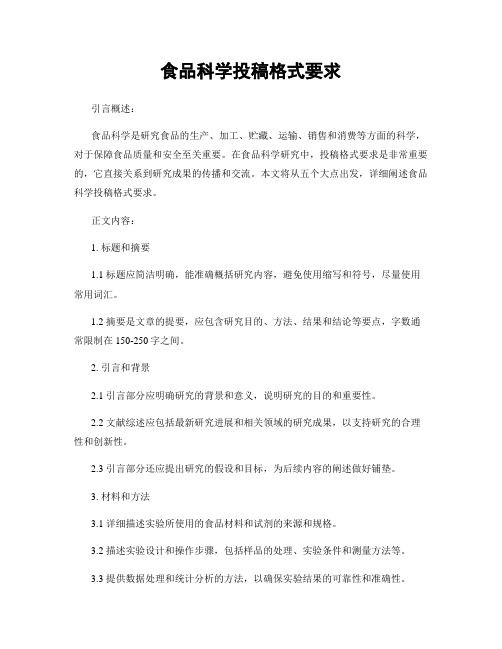
食品科学投稿格式要求引言概述:食品科学是研究食品的生产、加工、贮藏、运输、销售和消费等方面的科学,对于保障食品质量和安全至关重要。
在食品科学研究中,投稿格式要求是非常重要的,它直接关系到研究成果的传播和交流。
本文将从五个大点出发,详细阐述食品科学投稿格式要求。
正文内容:1. 标题和摘要1.1 标题应简洁明确,能准确概括研究内容,避免使用缩写和符号,尽量使用常用词汇。
1.2 摘要是文章的提要,应包含研究目的、方法、结果和结论等要点,字数通常限制在150-250字之间。
2. 引言和背景2.1 引言部分应明确研究的背景和意义,说明研究的目的和重要性。
2.2 文献综述应包括最新研究进展和相关领域的研究成果,以支持研究的合理性和创新性。
2.3 引言部分还应提出研究的假设和目标,为后续内容的阐述做好铺垫。
3. 材料和方法3.1 详细描述实验所使用的食品材料和试剂的来源和规格。
3.2 描述实验设计和操作步骤,包括样品的处理、实验条件和测量方法等。
3.3 提供数据处理和统计分析的方法,以确保实验结果的可靠性和准确性。
4. 结果和讨论4.1 结果部分应以文字和图表的形式呈现,清晰地展示实验结果。
4.2 对实验结果进行客观分析和解释,与引言部分的研究目标和假设进行对比。
4.3 结果讨论应结合已有研究成果,分析研究结果的优缺点,并提出可能的原因和改进措施。
5. 结论和展望5.1 简明扼要地总结研究的主要结果和发现。
5.2 结论应回答引言中提出的研究目标和假设,强调研究的创新性和实用性。
5.3 展望部分可以提出进一步的研究方向和改进的建议,为读者提供参考。
总结:食品科学投稿格式要求是确保研究成果有效传播和交流的重要环节。
文章的标题和摘要应简洁明确,引言和背景部分应明确研究的背景和意义,材料和方法部分应详细描述实验的设计和操作步骤,结果和讨论部分应客观分析实验结果,结论和展望部分应总结研究成果并提出进一步的研究方向。
通过遵循食品科学投稿格式要求,可以提高研究成果的可信度和可读性,促进学术交流和合作。
食品研究与开发稿件格式

食品研究与开发稿件格式一、稿件二、作者信息1. 作者姓名:请使用真实姓名,并按照“第一作者,第二作者,第三作者”的顺序排列。
2. 作者单位:请提供作者所在单位的名称、地址、邮编和联系电话。
3. 作者简介:简要介绍作者的研究方向、学术背景和研究成果。
三、摘要四、关键词关键词应能够准确反映文章的主题和研究方向,一般选择35个关键词。
五、引言六、研究方法七、结果与讨论八、结论十、其他要求2. 文章应使用简洁明了的语言,避免使用过于专业的术语和复杂的句式。
3. 文章应保证内容的原创性,不得抄袭或剽窃他人的研究成果。
4. 文章应遵守学术道德规范,不得涉及任何违法违规的内容。
十一、投稿方式请将稿件发送至指定的投稿邮箱,并注明“食品研究与开发稿件投稿”字样。
十二、审稿周期稿件提交后,编辑部将在2周内完成初审,并通知作者是否录用。
如需修改,编辑部将提供修改意见,并要求作者在规定时间内完成修改。
十三、版权声明稿件录用后,作者应将文章的版权转让给编辑部,编辑部有权对文章进行修改、编辑和出版。
食品研究与开发稿件格式一、稿件二、作者信息1. 作者姓名:请使用真实姓名,并按照“第一作者,第二作者,第三作者”的顺序排列。
2. 作者单位:请提供作者所在单位的名称、地址、邮编和联系电话。
3. 作者简介:简要介绍作者的研究方向、学术背景和研究成果。
三、摘要四、关键词关键词应能够准确反映文章的主题和研究方向,一般选择35个关键词。
五、引言六、研究方法七、结果与讨论八、结论十、其他要求2. 文章应使用简洁明了的语言,避免使用过于专业的术语和复杂的句式。
3. 文章应保证内容的原创性,不得抄袭或剽窃他人的研究成果。
4. 文章应遵守学术道德规范,不得涉及任何违法违规的内容。
十一、投稿方式请将稿件发送至指定的投稿邮箱,并注明“食品研究与开发稿件投稿”字样。
十二、审稿周期稿件提交后,编辑部将在2周内完成初审,并通知作者是否录用。
如需修改,编辑部将提供修改意见,并要求作者在规定时间内完成修改。
食品科学投稿格式要求
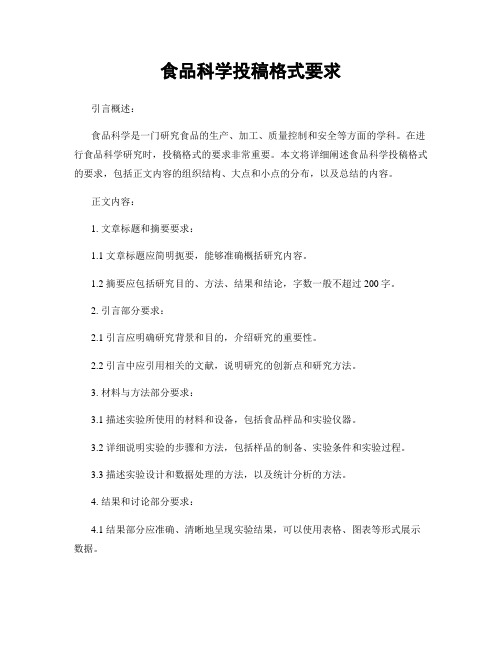
食品科学投稿格式要求引言概述:食品科学是一门研究食品的生产、加工、质量控制和安全等方面的学科。
在进行食品科学研究时,投稿格式的要求非常重要。
本文将详细阐述食品科学投稿格式的要求,包括正文内容的组织结构、大点和小点的分布,以及总结的内容。
正文内容:1. 文章标题和摘要要求:1.1 文章标题应简明扼要,能够准确概括研究内容。
1.2 摘要应包括研究目的、方法、结果和结论,字数一般不超过200字。
2. 引言部分要求:2.1 引言应明确研究背景和目的,介绍研究的重要性。
2.2 引言中应引用相关的文献,说明研究的创新点和研究方法。
3. 材料与方法部分要求:3.1 描述实验所使用的材料和设备,包括食品样品和实验仪器。
3.2 详细说明实验的步骤和方法,包括样品的制备、实验条件和实验过程。
3.3 描述实验设计和数据处理的方法,以及统计分析的方法。
4. 结果和讨论部分要求:4.1 结果部分应准确、清晰地呈现实验结果,可以使用表格、图表等形式展示数据。
4.2 讨论部分应对实验结果进行解释和分析,与已有研究进行比较,说明研究的意义和贡献。
4.3 讨论部分还可以提出研究中存在的问题和不足之处,以及进一步的研究方向。
5. 结论部分要求:5.1 结论应简明扼要地总结研究的主要发现和结果。
5.2 结论中可以指出研究的局限性,并提出对未来研究的建议。
总结:综上所述,食品科学投稿格式要求包括文章标题和摘要的要求,引言部分的要求,材料与方法部分的要求,结果和讨论部分的要求,以及结论部分的要求。
在撰写食品科学研究论文时,作者应注意按照规定的格式进行组织,确保文章的准确性和专业性。
此外,还应注意引用相关文献和提出进一步研究的建议,以提高文章的质量和学术价值。
食品科学期刊发表要求

食品科学期刊发表要求食品科学是一门研究食品的生产、加工、储藏、运输、销售以及与人体健康相关的科学。
食品科学期刊是一个重要的学术出版物,它旨在传播最新的食品科学研究成果,促进学术交流和合作。
在投稿之前,作者需要了解食品科学期刊的发表要求,以确保自己的研究能够符合期刊的标准并且成功发表。
首先,食品科学期刊对投稿的研究内容有一定的要求。
作者需要确保自己的研究内容具有一定的创新性和独特性,能够为食品科学领域带来新的见解和发现。
同时,研究内容需要与食品科学领域的热点和前沿问题相关,能够引起读者的兴趣并具有一定的学术价值。
此外,研究内容需要经过严谨的实验设计和科学的数据分析,确保研究结果的可靠性和准确性。
其次,食品科学期刊对投稿的文稿格式和语言表达也有一定的要求。
作者需要按照期刊的投稿模板进行排版,确保文稿的格式规范统一。
在语言表达上,作者需要尽可能地使用准确、生动、简洁的语言,避免出现冗长和啰嗦的表达方式。
同时,作者需要注意句子之间的逻辑联系,确保文稿的表达通顺流畅,语气一致。
最后,食品科学期刊对投稿的参考文献引用和版权问题也有一定的要求。
作者需要按照期刊的引用格式要求对参考文献进行准确的引用,并确保文中引用的内容符合版权规定,避免出现抄袭和侵权行为。
综上所述,食品科学期刊发表要求涉及研究内容、文稿格式、语言表达、参考文献引用和版权等多个方面。
作者在投稿之前需要对这些要求有一个清晰的了解,并且在撰写和投稿过程中严格遵守期刊的要求,以提高自己的投稿成功率。
同时,作者在投稿之前也可以通过查阅期刊的往期发表内容和编辑部的相关信息,了解期刊的特色和定位,有针对性地进行研究内容选择和文稿撰写,从而更好地适应期刊的发表要求。
食品工业科技投稿须知

注:此模板中内容上下并无关联性,是多篇文章的组合,主要目的是为作者提供本刊对稿件各部分的要求及书写格式稿件首页请按如下格式提供作者简介:姓名(出生年-),性别,学历,职称,研究方向。
属基金项目的需写明项目级别及项目编号。
大标题,应准确、清楚、简洁地概括全文,20个字以内,标题内不应出现缩写字作者姓名1,作者姓名2,*(如果第一作者不是联系人,请在通讯联系人右上角标注*,并在第一页最下方写上“* 通讯联系人”字样)(1. 作者单位正式对外名称,省份及城市邮编; 2. 作者单位正式对外名称,省份及城市邮编)摘要:至少5~6个整句,内容包括目的、方法、结果、结论(四要素缺一不可)等。
摘要应以第三人称撰写,避免使用“本文”、“作者”等词汇。
应写成报道性文摘,并具有独立性和自明性,即不阅读全文,就能获得全文的主要信息(特别注意所述内容均应包含在正文中,且数据一致)。
不要重复题目,给出文中的主要信息、关键步骤或数据,以便于检索;篇幅:报道性的以300字左右,指示性的以100字左右,报道—指示性的以200字左右为宜;缩写词首次出现时请给出全称,如:基质辅助激光解吸/电离飞行时间质谱(MALDI-TOFMS)。
关键词:列出3~5个关键词。
关键词应重点突出文章的主要内容和关键工艺,关键词之间用逗号相隔,结束处不用标点符号,缩写词请给出全称,如:气相色谱-质谱法(GC-MS)英文大标题应与中文完全对应,除第一个字母大写外,其它字母全部用小写(专有名词除外),不应出现缩写字,拉丁文需用斜体Effect of defatted soybean powder on noodle qualityMA Chen1, ZHENG Wen-xue2,*(1.Institute of Nuclear Energy Technology, Tsinaghua University, Beijing 100084,China;2. College of Bioengineering, Chengdu University, Chengdu 610106,China)Abstract: 英文摘要一般与中文摘要内容相对应;缩写词首次出现时请给出全称用被动语态陈述;用于说明研究目的、叙述研究内容、描述结果、得出结论、提出建议或讨论等时用一般现在时,用于叙述过去某一时刻(时段)的发现、某一研究过程(实验、观察、调查、医疗等过程)时用一般过去时;尽可能简洁;人称要采用第三人称;拉丁文应用斜体。
食品科学投稿模板
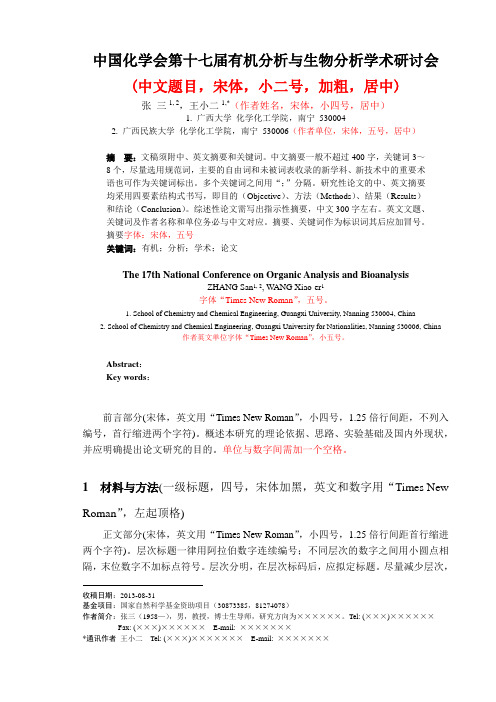
中国化学会第十七届有机分析与生物分析学术研讨会(中文题目,宋体,小二号,加粗,居中)张三1, 2,王小二1,*(作者姓名,宋体,小四号,居中)1. 广西大学化学化工学院,南宁5300042. 广西民族大学化学化工学院,南宁530006(作者单位,宋体,五号,居中)摘要:文稿须附中、英文摘要和关键词。
中文摘要一般不超过400字,关键词3~8个,尽量选用规范词,主要的自由词和未被词表收录的新学科、新技术中的重要术语也可作为关键词标出。
多个关键词之间用“;”分隔。
研究性论文的中、英文摘要均采用四要素结构式书写,即目的(Objective)、方法(Methods)、结果(Results)和结论(Conclusion)。
综述性论文需写出指示性摘要,中文300字左右。
英文文题、关键词及作者名称和单位务必与中文对应。
摘要、关键词作为标识词其后应加冒号。
摘要字体:宋体,五号关键词:有机;分析;学术;论文The 17th National Conference on Organic Analysis and BioanalysisZHANG San1, 2, W ANG Xiao-er1字体“Times New Roman”,五号。
1. School of Chemistry and Chemical Engineering, Guangxi University, Nanning 530004, China2. School of Chemistry and Chemical Engineering, Guangxi University for Nationalities, Nanning 530006, China作者英文单位字体“Times New Roman”,小五号。
Abstract:Key words:前言部分(宋体,英文用“Times New Roman”,小四号,1.25倍行间距,不列入编号,首行缩进两个字符)。
食品化学投稿要求
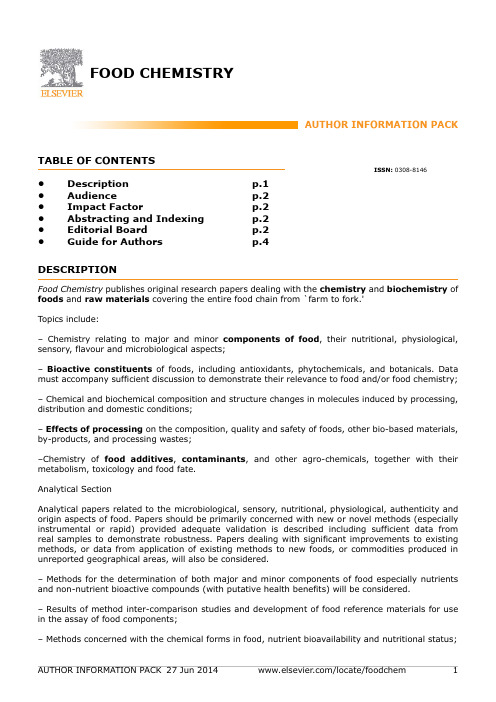
FOOD CHEMISTRYAUTHOR INFORMATION PACK TABLE OF CONTENTS• Description• Audience• Impact Factor• Abstracting and Indexing • Editorial Board• Guide for Authors p.1p.2p.2p.2p.2p.4ISSN: 0308-8146DESCRIPTIONFood Chemistry publishes original research papers dealing with the chemistry and biochemistry of foods and raw materials covering the entire food chain from `farm to fork.'Topics include:– Chemistry relating to major and minor components of food, their nutritional, physiological, sensory, flavour and microbiological aspects;– Bioactive constituents of foods, including antioxidants, phytochemicals, and botanicals. Data must accompany sufficient discussion to demonstrate their relevance to food and/or food chemistry;– Chemical and biochemical composition and structure changes in molecules induced by processing, distribution and domestic conditions;– Effects of processing on the composition, quality and safety of foods, other bio-based materials, by-products, and processing wastes;–Chemistry of food additives, contaminants, and other agro-chemicals, together with their metabolism, toxicology and food fate.Analytical SectionAnalytical papers related to the microbiological, sensory, nutritional, physiological, authenticity and origin aspects of food. Papers should be primarily concerned with new or novel methods (especially instrumental or rapid) provided adequate validation is described including sufficient data from real samples to demonstrate robustness. Papers dealing with significant improvements to existing methods, or data from application of existing methods to new foods, or commodities produced in unreported geographical areas, will also be considered.– Methods for the determination of both major and minor components of food especially nutrients and non-nutrient bioactive compounds (with putative health benefits) will be considered.– Results of method inter-comparison studies and development of food reference materials for use in the assay of food components;– Methods concerned with the chemical forms in food, nutrient bioavailability and nutritional status;– General authentication and origin [e.g. Country of Origin Labelling (COOL), Protected Designation of Origin (PDO), Protected Geographical Indication (PGI), Certificate of Specific Character (CSC)] determination of foods (both geographical and production including commodity substitution, and verification of organic, biological and ecological labelling) providing sufficient data from authentic samples should be included to ensure that interpretations are meaningful.AUDIENCEFood technologists, scientists and chemistsIMPACT FACTOR2012: 3.334 © Thomson Reuters Journal Citation Reports 2013ABSTRACTING AND INDEXINGBIOSISChemical AbstractsChemical Engineering Biotechnology AbstractsCurrent ContentsEMBASEFSTA (Food Science and Technology Abstracts)Nutrition AbstractsPublications in Food MicrobiologySCISEARCHScience Citation IndexCAB AbstractsSociedad Iberoamericana de Informacion Cientifica (SIIC) Data BasesScopusGlobal HealthEMBiologyEDITORIAL BOARDEditor-in-ChiefG.G. Birch, Food and Nutritional Sciences, University of Reading, PO Box 217 Whiteknights, Reading, RG6 6AH, UKEditor: Analytical, Nutritional and Clinical Methods SectionP. Finglas, Inst. of Food Research, Nutrition Health & Con, Norwich Laboratory, Colney Lane, Colney, Norwich, NR4 7UA, UKL. Melton, School of Chemical Sciences, University of Auckland, 1142, Auckland, New ZealandEditorsS.B. Astley, EuroFIR AISBL, Brussels, BelgiumD. Charalampopoulos, University of Reading, Reading, UKS. Elmore, University of Reading, Reading, England, UKS.Y. Jiang, Peking University, Beijing, ChinaL. Melton, University of Auckland, Auckland, New ZealandF. Shahidi, Memorial University of Newfoundland, St John's, CanadaJ. Van Camp, Universiteit Gent, Gent, BelgiumR. Wrolstad, Oregon State University, Corvallis, Oregon, USAEditorial Board MembersC. Alasalvar, Tubitak Marmara Research Center, Gebze/Kocaeli, TurkeyA. Andrews, University of Wales, Penylan, Cardiff, UKJ.H. Banoub, Fisheries and Oceans Canada, St. John's, Newfoundland and Labrador, CanadaY. Bao, University of East Anglia, Norwich, UKM. Battino, Università Politecnica delle Marche, Ancona, ItalyR.G. Berger, Leibniz Universität Hannover, Hannover, GermanyT. Beta, University of Manitoba, Winnipeg, Manitoba, CanadaY.F. Chu, Kraft Foods, Glenview, Illinois, USAP. Dey, Royal Holloway, University of London, Egham, UKD Granato, Universidade Estadual de Ponta Grossa, Ponta Grossa, BrazilA. Halmos, RMIT, Melbourne, AustraliaA. Ismail, University Putra Malaysia, Upm Serdang, MalaysiaM. Jenner, Devon, UKM. Jung, Woosuk University, Jeonbuk, South KoreaS. Kelly, University of East Anglia, Norwich, England, UKJ.F. Kennedy, Chembiotech Laboratories, Worcester, UKP. Kilmartin, University of Auckland, Auckland Mail Centre, Auckland, New ZealandJ. Lakkis, Pfizer Global Research and Development, Morris Plains, New Jersey, USAC.K. Lee, Penange, MalaysiaG. Lisinska, Wageningen Universiteit, Wroclaw, PolandM. Mathlouthi, Université de Reims Champagne-Ardenne, Reims Cedex, FranceB. Ou, International Chemistry Testing, Milford, Massachusetts, USAR. Pegg, University of Georgia, Athens, Georgia, USAV. Piironen, University of Helsinki, Helsinki, FinlandS. Polesello, National Research Council of Italy (CNR), Brugherio, ItalyS. Porretta, Stazione Sperimentale per L'Industria delle Conserve Alimentari, Parma, Italy P. Puwastien, Mahidol University, Nakhon Pathom, ThailandE. Risvik, Matforsk, As, NorwayA. Ritieni, Università di Napoli Federico II, Napoli, ItalyB. Saad, Universiti Sains Malaysia, Nibong Tebal, Penang, MalaysiaH. Schönfeldt, University of Pretoria, Pretoria, South AfricaJ-H. Shim, Chonnam National University, Gwangiu, South KoreaJaspreet Singh, Massey University, Palmerston North, New ZealandK. Thurlow, LGC Limited, Teddington, UKF. Toldrá, Instituto de Agroquimica y Tecnologia de Alimentos, Paterna (Valencia), Spain R. Tsao, Agriculture and Agri-Food Canada (AAFC), Guelph, Ontario, CanadaA. Tudos, Shell Global Solutions, Amsterdam, NetherlandsF. Ulberth, European Commission, Geel, BelgiumC.M. Witthoft, Sveriges Lantbruks Universitet (SLU), Uppsala, SwedenV. Yaylayan, McGill University, Ste Anne de Bellevue, Quebec, CanadaL. Yu, University of Maryland, College Park, Maryland, USAR. Zeleny, European Commission, Geel, BelgiumJ. Zhengyu, Southern Yangtze University, Wuxi, Jiangsu Province, ChinaGUIDE FOR AUTHORSINTRODUCTIONTypes of paperOriginal research papers; review articles; rapid communications; short communications; viewpoints; letters to the Editor; book reviews.1.Research papers - original full-length research papers which have not been published previously, except in a preliminary form, and should not exceed 7,500 words (including allowance for no more than 6 tables and illustrations). Research papers should not contain more than 40 references.2.Review articles - will be accepted in areas of topical interest, will normally focus on literature published over the previous five years, and should not exceed 10,000 words (including allowance for no more than 6 tables and illustrations). Review articles should not contain more than 80 references. ) If it is felt absolutely necessary to exceed this number, please contact the editorial office for advice before submission.3.Rapid communications - an original research paper reporting a major scientific result or finding with significant implications for the research community, designated by the Editor.4.Short communications - Short communications of up to 3000 words, describing work that may be of a preliminary nature but which merits immediate publication. These papers should not contain more than 30 references.5.Viewpoints - Authors may submit viewpoints of about 1200 words on any subject covered by the Aims and Scope.6.Letters to the Editor - Letters are published from time to time on matters of topical interest.7.Book reviewsBEFORE YOU BEGINEthics in publishingFor information on Ethics in publishing and Ethical guidelines for journal publication see /publishingethics and /journal-authors/ethics.The work described in your article must have been carried out in accordance with The Code of Ethics of the World Medical Association (Declaration of Helsinki) for experiments involving humans /en/30publications/10policies/b3/index.html ; EU Directive 2010/63/EU for animal experiments http://ec.europa.eu/environment/chemicals/lab_animals/legislation_en.htm. Guidelines in the US and Canada, Europe and Australia specifically state that hypothermia (use of ice slurries) is not an acceptable method for killing fish in the research environment. We are aware that in the past papers using the same or similar methods have been accepted in Food Chemistry. However, the journal reserves the right to change/enforce submission criteria especially in the relation to publication of ethical research.Conflict of interestAll authors are requested to disclose any actual or potential conflict of interest including any financial, personal or other relationships with other people or organizations within three years of beginning the submitted work that could inappropriately influence, or be perceived to influence, their work. See also /conflictsofinterest. Further information and an example of a Conflict of Interest form can be found at: /app/answers/detail/a_id/286/p/7923. Submission declaration and verificationSubmission of an article implies that the work described has not been published previously (except in the form of an abstract or as part of a published lecture or academic thesis or as an electronic preprint, see /postingpolicy), that it is not under consideration for publication elsewhere, that its publication is approved by all authors and tacitly or explicitly by the responsible authorities where the work was carried out, and that, if accepted, it will not be published elsewhere in the same form, in English or in any other language, including electronically without the written consent of the copyright-holder. To verify originality, your article may be checked by the originality detection service CrossCheck /editors/plagdetect.Changes to authorshipThis policy concerns the addition, deletion, or rearrangement of author names in the authorship of accepted manuscripts:Before the accepted manuscript is published in an online issue: Requests to add or remove an author, or to rearrange the author names, must be sent to the Journal Manager from the corresponding author of the accepted manuscript and must include: (a) the reason the name should be added or removed, or the author names rearranged and (b) written confirmation (e-mail, fax, letter) from all authors that they agree with the addition, removal or rearrangement. In the case of addition or removal of authors, this includes confirmation from the author being added or removed. Requests that are not sent by the corresponding author will be forwarded by the Journal Manager to the corresponding author, who must follow the procedure as described above. Note that: (1) Journal Managers will inform the Journal Editors of any such requests and (2) publication of the accepted manuscript in an online issue is suspended until authorship has been agreed.After the accepted manuscript is published in an online issue: Any requests to add, delete, or rearrange author names in an article published in an online issue will follow the same policies as noted above and result in a corrigendum.CopyrightThis journal offers authors a choice in publishing their research: Open access and Subscription.For subscription articlesUpon acceptance of an article, authors will be asked to complete a 'Journal Publishing Agreement' (for more information on this and copyright, see /copyright). An e-mail will be sent to the corresponding author confirming receipt of the manuscript together with a 'Journal Publishing Agreement' form or a link to the online version of this agreement.Subscribers may reproduce tables of contents or prepare lists of articles including abstracts for internal circulation within their institutions. Permission of the Publisher is required for resale or distribution outside the institution and for all other derivative works, including compilations and translations (please consult /permissions). If excerpts from other copyrighted works are included, the author(s) must obtain written permission from the copyright owners and credit the source(s) in the article. Elsevier has preprinted forms for use by authors in these cases: please consult /permissions.For open access articlesUpon acceptance of an article, authors will be asked to complete an 'Exclusive License Agreement' (for more information see /OAauthoragreement). Permitted reuse of open access articles is determined by the author's choice of user license (see /openaccesslicenses).Retained author rightsAs an author you (or your employer or institution) retain certain rights. For more information on author rights for:Subscription articles please see /journal-authors/author-rights-and-responsibilities.Open access articles please see /OAauthoragreement.Role of the funding sourceYou are requested to identify who provided financial support for the conduct of the research and/or preparation of the article and to briefly describe the role of the sponsor(s), if any, in study design; in the collection, analysis and interpretation of data; in the writing of the report; and in the decision to submit the article for publication. If the funding source(s) had no such involvement then this should be stated.Funding body agreements and policiesElsevier has established agreements and developed policies to allow authors whose articles appear in journals published by Elsevier, to comply with potential manuscript archiving requirements as specified as conditions of their grant awards. To learn more about existing agreements and policies please visit /fundingbodies.Open accessThis journal offers authors a choice in publishing their research:Open access• Articles are freely available to both subscribers and the wider public with permitted reuse• An open access publication fee is payable by authors or their research funderSubscription• Articles are made available to subscribers as well as developing countries and patient groups through our access programs (/access)• No open access publication feeAll articles published open access will be immediately and permanently free for everyone to read and download. Permitted reuse is defined by your choice of one of the following Creative Commons user licenses:Creative Commons Attribution (CC BY): lets others distribute and copy the article, to create extracts, abstracts, and other revised versions, adaptations or derivative works of or from an article (such as a translation), to include in a collective work (such as an anthology), to text or data mine the article, even for commercial purposes, as long as they credit the author(s), do not represent the author as endorsing their adaptation of the article, and do not modify the article in such a way as to damage the author's honor or reputation.Creative Commons Attribution-NonCommercial-ShareAlike (CC BY-NC-SA): for non-commercial purposes, lets others distribute and copy the article, to create extracts, abstracts and other revised versions, adaptations or derivative works of or from an article (such as a translation), to include in a collective work (such as an anthology), to text and data mine the article, as long as they credit the author(s), do not represent the author as endorsing their adaptation of the article, do not modify the article in such a way as to damage the author's honor or reputation, and license their new adaptations or creations under identical terms (CC BY-NC-SA).Creative Commons Attribution-NonCommercial-NoDerivs (CC BY-NC-ND): for non-commercial purposes, lets others distribute and copy the article, and to include in a collective work (such as an anthology), as long as they credit the author(s) and provided they do not alter or modify the article.To provide open access, this journal has a publication fee which needs to be met by the authors or their research funders for each article published open access.Your publication choice will have no effect on the peer review process or acceptance of submitted articles.The publication fee for this journal is $2,200, excluding taxes. Learn more about Elsevier's pricing policy: /openaccesspricing.Language (usage and editing services)Please write your text in good English (American or British usage is accepted, but not a mixture of these). Authors who feel their English language manuscript may require editing to eliminate possible grammatical or spelling errors and to conform to correct scientific English may wish to use the English Language Editing service available from Elsevier's WebShop (/languageediting/) or visit our customer support site () for more information.SubmissionSubmission to this journal proceeds totally online and you will be guided stepwise through the creation and uploading of your files. The system automatically converts source files to a single PDF file of the article, which is used in the peer-review process. Please note that even though manuscript source files are converted to PDF files at submission for the review process, these source files are needed for further processing after acceptance. All correspondence, including notification of the Editor's decision and requests for revision, takes place by e-mail removing the need for a paper trail.Authors must provide and use an email address unique to themselves and not shared with another author registered in EES, or a department.RefereesAuthors are required to submit, with the manuscript, the names, addresses and e-mail addresses of 3 potential referees. Note that the editor retains the sole right to decide whether or not the suggested reviewers are used.Review PolicyA peer review system involving two or three reviewers is used to ensure high quality of manuscripts accepted for publication. The Managing Editor and Editors have the right to decline formal review ofa manuscript when it is deemed that the manuscript is1) on a topic outside the scope of the Journal;2) lacking technical merit;3) focused on foods or processes that are of narrow regional scope and significance;4) fragmentary and providing marginally incremental results; or5) is poorly written.PREPARATIONUse of wordprocessing softwareGeneral: Manuscripts must be typewritten, double-spaced with wide margins on one side of white paper. Each page must be numbered, and lines must be consecutively numbered from the start to the end of the manuscript. Good quality printouts with a font size of 12 or 10 pt are required. The corresponding author should be identified (include a Fax number and E-mail address). Full postal addresses must be given for all co-authors. Authors should consult a recent issue of the journal for style if possible. An electronic copy of the paper should accompany the final version. The Editors reserve the right to adjust style to certain standards of uniformity. Authors should retain a copy of their manuscript since we cannot accept responsibility for damage or loss of papers. Original manuscripts are discarded one month after publication unless the Publisher is asked to return original material after use.Article structureFollow this order when typing manuscripts: Title, Authors, Affiliations, Abstract, Keywords, Main text, Acknowledgements, Appendix, References, Vitae, Figure Captions and then Tables. Do not import the Figures or Tables into your text. The corresponding author should be identified with an asterisk and footnote. All other footnotes (except for table footnotes) should be identified with superscript Arabic numbers. The title of the paper should unambiguously reflect its contents. Where the title exceeds 70 characters a suggestion for an abbreviated running title should be given.Subdivision - numbered sectionsDivide your article into clearly defined and numbered sections. Subsections should be numbered 1.1 (then 1.1.1, 1.1.2, ...), 1.2, etc. (the abstract is not included in section numbering). Use this numbering also for internal cross-referencing: do not just refer to 'the text'. Any subsection may be given a brief heading. Each heading should appear on its own separate line.Essential title page information• Title.Concise and informative. Titles are often used in information-retrieval systems. Avoid abbreviations and formulae where possible.• Author names and affiliations. Where the family name may be ambiguous (e.g., a double name), please indicate this clearly. Present the authors' affiliation addresses (where the actual work was done) below the names. Indicate all affiliations with a lower-case superscript letter immediately after the author's name and in front of the appropriate address. Provide the full postal address of each affiliation, including the country name and, if available, the e-mail address of each author.• Corresponding author. Clearly indicate who will handle correspondence at all stages of refereeing and publication, also post-publication. Ensure that phone numbers (with country and area code) are provided in addition to the e-mail address and the complete postal address. Contact details must be kept up to date by the corresponding author.• Present/permanent address. If an author has moved since the work described in the article was done, or was visiting at the time, a 'Present address' (or 'Permanent address') may be indicated as a footnote to that author's name. The address at which the author actually did the work must be retained as the main, affiliation address. Superscript Arabic numerals are used for such footnotes. AbstractA concise and factual abstract is required. The abstract should state briefly the purpose of the research, the principal results and major conclusions. An abstract is often presented separately from the article, so it must be able to stand alone. For this reason, References should be avoided, but if essential, then cite the author(s) and year(s). Also, non-standard or uncommon abbreviations should be avoided, but if essential they must be defined at their first mention in the abstract itself.The abstract should not exceed 150 words.HighlightsHighlights are mandatory for this journal. They consist of a short collection of bullet points that convey the core findings of the article and should be submitted in a separate file in the online submission system. Please use 'Highlights' in the file name and include 3 to 5 bullet points (maximum 85 characters, including spaces, per bullet point). See /highlights for examples.Chemical compoundsYou can enrich your article by providing a list of chemical compounds studied in the article. The list of compounds will be used to extract relevant information from the NCBI PubChem Compound database and display it next to the online version of the article on ScienceDirect. You can include up to 10 names of chemical compounds in the article. For each compound, please provide the PubChem CID of the most relevant record as in the following example: Glutamic acid (PubChem CID:611). The PubChem CIDs can be found via /pccompound. Please position the list of compounds immediately below the 'Keywords' section. It is strongly recommended to follow the exact text formatting as in the example below:Chemical compounds studied in this articleEthylene glycol (PubChem CID: 174); Plitidepsin (PubChem CID: 44152164); Benzalkonium chloride (PubChem CID: 15865)More information is available at: /PubChem.UnitsFollow internationally accepted rules and conventions: use the international system of units (SI). If other units are mentioned, please give their equivalent in SI.Temperatures should be given in degrees Celsius. The unit 'billion' is ambiguous and should not be used.Database linkingElsevier encourages authors to connect articles with external databases, giving their readers one-click access to relevant databases that help to build a better understanding of the described research. Please refer to relevant database identifiers using the following format in your article: Database: xxxx (e.g., TAIR: AT1G01020; CCDC: 734053; PDB: 1XFN). See /databaselinking for more information and a full list of supported databases.ArtworkElectronic artworkGeneral points• Make sure you use uniform lettering and sizing of your original artwork.• Embed the used fonts if the application provides that option.• Aim to use the following fonts in your illustrations: Arial, Courier, Times New Roman, Symbol, or use fonts that look similar.• Number the illustrations according to their sequence in the text.• Use a logical naming convention for your artwork files.• Provide captions to illustrations separately.• Size the illustrations close to the desired dimensions of the printed version.• Submit each illustration as a separate file.A detailed guide on electronic artwork is available on our website:/artworkinstructionsYou are urged to visit this site; some excerpts from the detailed information are given here. FormatsIf your electronic artwork is created in a Microsoft Office application (Word, PowerPoint, Excel) then please supply 'as is' in the native document format.Regardless of the application used other than Microsoft Office, when your electronic artwork is finalized, please 'Save as' or convert the images to one of the following formats (note the resolution requirements for line drawings, halftones, and line/halftone combinations given below):EPS (or PDF): Vector drawings, embed all used fonts.TIFF (or JPEG): Color or grayscale photographs (halftones), keep to a minimum of 300 dpi.TIFF (or JPEG): Bitmapped (pure black & white pixels) line drawings, keep to a minimum of 1000 dpi. TIFF (or JPEG): Combinations bitmapped line/half-tone (color or grayscale), keep to a minimum of 500 dpi.Please do not:• Supply files that are optimized for screen use (e.g., GIF, BMP, PICT, WPG); these typically have a low number of pixels and limited set of colors;• Supply files that are too low in resolution;• Submit graphics that are disproportionately large for the content.Please insert the following text before the standard text - Photographs, charts and diagrams are all to be referred to as "Figure(s)" and should be numbered consecutively in the order to which they are referred. They should accompany the manuscript, but should not be included within the text. All illustrations should be clearly marked with the figure number and the author's name. All figures are to have a caption. Captions should be supplied on a separate sheet.Color artworkPlease make sure that artwork files are in an acceptable format (TIFF (or JPEG), EPS (or PDF), or MS Office files) and with the correct resolution. If, together with your accepted article, you submit usable color figures then Elsevier will ensure, at no additional charge, that these figures will appear in color on the Web (e.g., ScienceDirect and other sites) regardless of whether or not these illustrations are reproduced in color in the printed version. For color reproduction in print, you will receive information regarding the costs from Elsevier after receipt of your accepted article. Please indicate your preference for color: in print or on the Web only. For further information on the preparation of electronic artwork, please see /artworkinstructions.Please note: Because of technical complications which can arise by converting color figures to 'gray scale' (for the printed version should you not opt for color in print) please submit in addition usable black and white versions of all the color illustrations.Figure captionsEnsure that each illustration has a caption. Supply captions separately, not attached to the figure. A caption should comprise a brief title (not on the figure itself) and a description of the illustration. Keep text in the illustrations themselves to a minimum but explain all symbols and abbreviations used. TablesNumber tables consecutively in accordance with their appearance in the text. Place footnotes to tables below the table body and indicate them with superscript lowercase letters. Avoid vertical rules. Be sparing in the use of tables and ensure that the data presented in tables do not duplicate results described elsewhere in the article.ReferencesCitation in textPlease ensure that every reference cited in the text is also present in the reference list (and vice versa). Any references cited in the abstract must be given in full. Unpublished results and personal communications are not recommended in the reference list, but may be mentioned in the text. If these references are included in the reference list they should follow the standard reference style of the journal and should include a substitution of the publication date with either 'Unpublished results' or 'Personal communication'. Citation of a reference as 'in press' implies that the item has been accepted for publication.Web referencesAs a minimum, the full URL should be given and the date when the reference was last accessed. Any further information, if known (DOI, author names, dates, reference to a source publication, etc.), should also be given. Web references can be listed separately (e.g., after the reference list) under a different heading if desired, or can be included in the reference list.Example: CTAHR (College of Tropical Agriculture and Human Resources, University of Hawaii). Tea (Camellia sinensis) a New Crop for Hawaii, 2007. URL /oc/freepubs/pdf/tea_04_07.pdf . Accessed 14.02.11.All publications cited in the text should be presented in a list of references following the text of the manuscript. See Types of Paper for reference number limits. In the text refer to the author's name (without initials) and year of publication (e.g. "Steventon, Donald and Gladden (1994) studied the effects..." or "...similar to values reported by others (Anderson, Douglas, Morrison & Weiping, 1990)..."). For 2-6 authors all authors are to be listed at first citation. At subsequent citations use first author et al.. When there are more than 6 authors, first author et al. should be used throughout the text. The list of references should be arranged alphabetically by authors' names and should be as full as possible, listing all authors, the full title of articles and journals, publisher and year. The manuscript should be carefully checked to ensure that the spelling of authors' names and dates are exactly the same in the text as in the reference list.。
食品科学投稿格式要求

食品科学投稿格式要求引言概述:食品科学是研究食品的生产、加工、储存、分析和评价等方面的科学。
对于食品科学研究者来说,了解食品科学投稿的格式要求是非常重要的,因为这直接关系到他们的研究成果是否能够被学术界所接受和认可。
本文将从五个大点来阐述食品科学投稿的格式要求。
正文内容:1. 文章标题和摘要1.1 文章标题应简明扼要,能够准确表达研究内容,不超过15个字。
1.2 摘要应包括研究目的、方法、结果和结论,字数一般不超过250字。
2. 引言2.1 引言应明确研究背景和目的,说明研究的重要性和意义。
2.2 引言中还应包括前人研究的综述,指出自己研究与前人研究的差异和创新点。
3. 材料与方法3.1 描述实验所用的食材和仪器设备,包括食材的来源和处理方法,仪器设备的型号和使用方法。
3.2 详细描述实验的步骤和操作方法,使读者能够重复实验并得到相似的结果。
3.3 对于统计分析方法,应明确使用的统计学方法和软件,并描述数据处理的步骤。
4. 结果与讨论4.1 结果部分应以文字、表格或图表的形式展示实验结果,清晰明了。
4.2 结果的讨论部分应分析实验结果,与前人研究进行比较,指出研究的局限性和不足之处。
4.3 结果与讨论的内容应紧密联系,逻辑清晰,能够回答研究问题。
5. 结论5.1 结论应简明扼要地总结研究的主要发现和结论。
5.2 结论中还可以提出进一步的研究方向和建议。
5.3 结论的内容应与引言和结果讨论部分相一致。
总结:综上所述,食品科学投稿的格式要求包括文章标题和摘要、引言、材料与方法、结果与讨论以及结论等五个大点。
在写作过程中,应注重简明扼要,逻辑清晰,遵循学术规范。
同时,还需注意前人研究的综述和结果的分析,以及对研究的局限性和不足之处的指出。
最后,在结论中对研究的主要发现进行总结,并提出进一步研究的方向和建议。
只有严格遵守这些格式要求,才能使研究成果得到学术界的认可和推崇。
农业食品化学投稿要求

农业食品化学投稿要求
一、内容要求:
1.研究目的和背景:文章应明确阐述研究的目的和背景。
研究目的应
该明确表述为解决一些具体问题或者填补一些领域的知识空白。
研究背景
则是对相关研究和理论的综述,说明该研究的重要性和创新性。
2.研究方法:文章应详细描述研究所采用的实验方法,包括实验设计、样品处理、仪器分析等。
实验方法应尽量符合科学原则并具备可重复性。
3.实验结果和分析:文章应清晰地陈述实验结果,并对结果给出可靠
的数据支持。
对结果进行科学的分析,解释结果的原因和意义。
可以适当
运用图表和数据统计方法来展示实验结果。
4.讨论和结论:文章的讨论部分应对实验结果进行深入分析和讨论,
提出相关问题和答案。
结论部分应对研究目的进行总结,阐明研究的原创
性和意义。
二、格式要求:
1.标题和摘要:文章标题应简明扼要地概括研究内容,并吸引读者的
兴趣。
摘要应包括研究的目的、方法、结果和结论,具有概括全文的作用。
摘要一般不超过200字。
3.图表和公式:文章中的图表和公式应具备清晰、准确、美观的特点。
图表和公式的编号和标题应清晰明了,便于读者理解。
4.语言表达:文章应使用准确、简洁的语言,避免专业术语的滥用和
错用。
句子结构要清晰,语法错误要尽量避免。
文章的内容应严谨、准确,表达逻辑要严密。
总之,农业食品化学投稿要求内容准确、科学、合理,格式规范、清晰、美观。
通过符合这些要求,才能使投稿的成果更具有可读性和可评价性,更有可能被同行专家和读者所接受和认可。
食品科学投稿模板
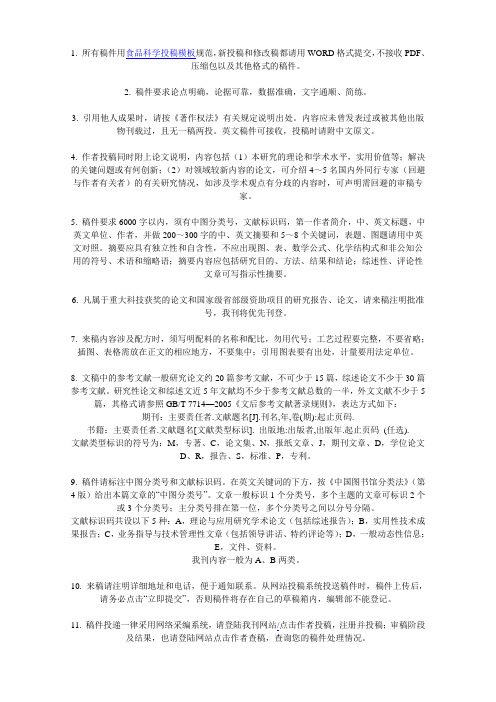
1. 所有稿件用食品科学投稿模板规范,新投稿和修改稿都请用WORD格式提交,不接收PDF、压缩包以及其他格式的稿件。
2. 稿件要求论点明确,论据可靠,数据准确,文字通顺、简练。
3. 引用他人成果时,请按《著作权法》有关规定说明出处。
内容应未曾发表过或被其他出版物刊载过,且无一稿两投。
英文稿件可接收,投稿时请附中文原文。
4. 作者投稿同时附上论文说明,内容包括(1)本研究的理论和学术水平,实用价值等;解决的关键问题或有何创新;(2)对领域较新内容的论文,可介绍4~5名国内外同行专家(回避与作者有关者)的有关研究情况,如涉及学术观点有分歧的内容时,可声明需回避的审稿专家。
5. 稿件要求6000字以内,须有中图分类号,文献标识码,第一作者简介,中、英文标题,中英文单位、作者,并做200~300字的中、英文摘要和5~8个关键词,表题、图题请用中英文对照。
摘要应具有独立性和自含性,不应出现图、表、数学公式、化学结构式和非公知公用的符号、术语和缩略语;摘要内容应包括研究目的、方法、结果和结论;综述性、评论性文章可写指示性摘要。
6. 凡属于重大科技获奖的论文和国家级省部级资助项目的研究报告、论文,请来稿注明批准号,我刊将优先刊登。
7. 来稿内容涉及配方时,须写明配料的名称和配比,勿用代号;工艺过程要完整,不要省略;插图、表格需放在正文的相应地方,不要集中;引用图表要有出处,计量要用法定单位。
8. 文稿中的参考文献一般研究论文约20篇参考文献,不可少于15篇,综述论文不少于30篇参考文献。
研究性论文和综述文近5年文献均不少于参考文献总数的一半,外文文献不少于5篇,其格式请参照GB/T 7714—2005《文后参考文献著录规则》,表达方式如下:期刊:主要责任者.文献题名[J].刊名,年,卷(期):起止页码.书籍:主要责任者.文献题名[文献类型标识]. 出版地:出版者,出版年.起止页码(任选).文献类型标识的符号为:M,专著、C,论文集、N,报纸文章、J,期刊文章、D,学位论文D、R,报告、S,标准、P,专利。
食品科学投稿交流会发言稿
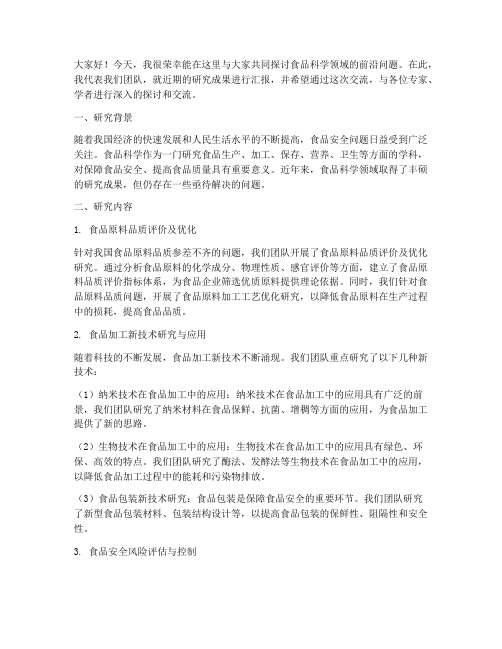
大家好!今天,我很荣幸能在这里与大家共同探讨食品科学领域的前沿问题。
在此,我代表我们团队,就近期的研究成果进行汇报,并希望通过这次交流,与各位专家、学者进行深入的探讨和交流。
一、研究背景随着我国经济的快速发展和人民生活水平的不断提高,食品安全问题日益受到广泛关注。
食品科学作为一门研究食品生产、加工、保存、营养、卫生等方面的学科,对保障食品安全、提高食品质量具有重要意义。
近年来,食品科学领域取得了丰硕的研究成果,但仍存在一些亟待解决的问题。
二、研究内容1. 食品原料品质评价及优化针对我国食品原料品质参差不齐的问题,我们团队开展了食品原料品质评价及优化研究。
通过分析食品原料的化学成分、物理性质、感官评价等方面,建立了食品原料品质评价指标体系,为食品企业筛选优质原料提供理论依据。
同时,我们针对食品原料品质问题,开展了食品原料加工工艺优化研究,以降低食品原料在生产过程中的损耗,提高食品品质。
2. 食品加工新技术研究与应用随着科技的不断发展,食品加工新技术不断涌现。
我们团队重点研究了以下几种新技术:(1)纳米技术在食品加工中的应用:纳米技术在食品加工中的应用具有广泛的前景,我们团队研究了纳米材料在食品保鲜、抗菌、增稠等方面的应用,为食品加工提供了新的思路。
(2)生物技术在食品加工中的应用:生物技术在食品加工中的应用具有绿色、环保、高效的特点。
我们团队研究了酶法、发酵法等生物技术在食品加工中的应用,以降低食品加工过程中的能耗和污染物排放。
(3)食品包装新技术研究:食品包装是保障食品安全的重要环节。
我们团队研究了新型食品包装材料、包装结构设计等,以提高食品包装的保鲜性、阻隔性和安全性。
3. 食品安全风险评估与控制食品安全风险评估与控制是食品科学领域的重要研究方向。
我们团队针对食品安全风险,开展了以下研究:(1)食品安全风险评估模型构建:针对不同食品类别,建立了食品安全风险评估模型,为食品安全监管提供科学依据。
食品有关期刊发表要求
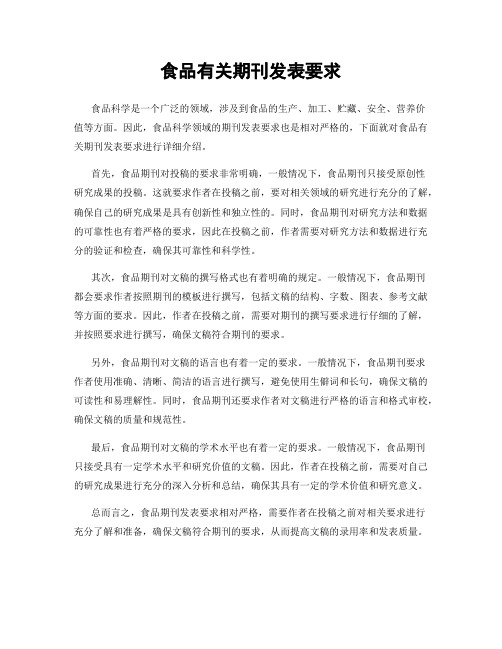
食品有关期刊发表要求食品科学是一个广泛的领域,涉及到食品的生产、加工、贮藏、安全、营养价值等方面。
因此,食品科学领域的期刊发表要求也是相对严格的,下面就对食品有关期刊发表要求进行详细介绍。
首先,食品期刊对投稿的要求非常明确,一般情况下,食品期刊只接受原创性研究成果的投稿。
这就要求作者在投稿之前,要对相关领域的研究进行充分的了解,确保自己的研究成果是具有创新性和独立性的。
同时,食品期刊对研究方法和数据的可靠性也有着严格的要求,因此在投稿之前,作者需要对研究方法和数据进行充分的验证和检查,确保其可靠性和科学性。
其次,食品期刊对文稿的撰写格式也有着明确的规定。
一般情况下,食品期刊都会要求作者按照期刊的模板进行撰写,包括文稿的结构、字数、图表、参考文献等方面的要求。
因此,作者在投稿之前,需要对期刊的撰写要求进行仔细的了解,并按照要求进行撰写,确保文稿符合期刊的要求。
另外,食品期刊对文稿的语言也有着一定的要求。
一般情况下,食品期刊要求作者使用准确、清晰、简洁的语言进行撰写,避免使用生僻词和长句,确保文稿的可读性和易理解性。
同时,食品期刊还要求作者对文稿进行严格的语言和格式审校,确保文稿的质量和规范性。
最后,食品期刊对文稿的学术水平也有着一定的要求。
一般情况下,食品期刊只接受具有一定学术水平和研究价值的文稿。
因此,作者在投稿之前,需要对自己的研究成果进行充分的深入分析和总结,确保其具有一定的学术价值和研究意义。
总而言之,食品期刊发表要求相对严格,需要作者在投稿之前对相关要求进行充分了解和准备,确保文稿符合期刊的要求,从而提高文稿的录用率和发表质量。
现代食品科技投稿模板
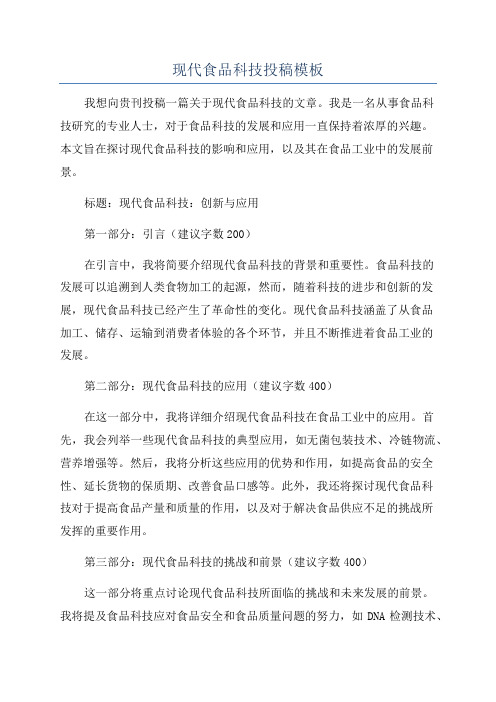
现代食品科技投稿模板我想向贵刊投稿一篇关于现代食品科技的文章。
我是一名从事食品科技研究的专业人士,对于食品科技的发展和应用一直保持着浓厚的兴趣。
本文旨在探讨现代食品科技的影响和应用,以及其在食品工业中的发展前景。
标题:现代食品科技:创新与应用第一部分:引言(建议字数200)在引言中,我将简要介绍现代食品科技的背景和重要性。
食品科技的发展可以追溯到人类食物加工的起源,然而,随着科技的进步和创新的发展,现代食品科技已经产生了革命性的变化。
现代食品科技涵盖了从食品加工、储存、运输到消费者体验的各个环节,并且不断推进着食品工业的发展。
第二部分:现代食品科技的应用(建议字数400)在这一部分中,我将详细介绍现代食品科技在食品工业中的应用。
首先,我会列举一些现代食品科技的典型应用,如无菌包装技术、冷链物流、营养增强等。
然后,我将分析这些应用的优势和作用,如提高食品的安全性、延长货物的保质期、改善食品口感等。
此外,我还将探讨现代食品科技对于提高食品产量和质量的作用,以及对于解决食品供应不足的挑战所发挥的重要作用。
第三部分:现代食品科技的挑战和前景(建议字数400)这一部分将重点讨论现代食品科技所面临的挑战和未来发展的前景。
我将提及食品科技应对食品安全和食品质量问题的努力,如DNA检测技术、可追溯性系统等,以及其在创新食品产品和满足消费者需求方面的潜力。
同时,我也会探讨食品科技在可持续食品生产和环境保护方面的重要性,以及如何克服目前存在的技术和政策障碍。
第四部分:结论(建议字数200)在结论部分,我将总结现代食品科技的重要性和应用,并重申其对食品工业和社会的影响。
同时,我也将强调食品科技在解决全球食品安全和可持续发展问题中的关键作用。
最后,我将展望现代食品科技未来的发展前景,激发读者对于食品科技创新的兴趣和探索。
以上是本人拟稿的现代食品科技投稿模板,希望贵刊能给予我的稿件详细审阅和指导。
谢谢您的时间和关注,期待与贵刊合作。
现代食品科技论文格式

现代⾷品科技论⽂格式 ⾷品⼀直是⼈类⽣存和发展过程中⽐较关注的⾸要问题,⽽现代⾷品科技论⽂格式就是指进⾏论⽂写作时的样式要求,以及写作标准。
下⾯是店铺整理的现代⾷品科技论⽂格式,希望你能从中得到感悟! 现代⾷品科技论⽂格式 1 题⽬是科技论⽂的中⼼和总纲。
要求准确恰当、简明扼要、醒⽬规范、便于检索。
⼀篇论⽂题⽬不要超出20个字。
⽤⼩2号⿊体加粗,居中。
2 署名 署名表⽰论⽂作者声明对论⽂拥有著作权、愿意⽂责⾃负,同时便于读者与作者联系。
署名包括⼯作单位及联系⽅式。
⼯作单位应写全称并包括所在城市名称及邮政编码,有时为进⾏⽂献分析,要求作者提供性别、出⽣年⽉、职务职称、电话号码、e-mail等信息。
⽤⼩4号宋体 3 摘要 摘要是对论⽂的内容不加注释和评论的简短陈述,是⽂章内容的⾼度概括。
主要内容包括: 1)该项研究⼯作的内容、⽬的及其重要性。
2)所使⽤的实验⽅法。
3)总结研究成果,突出作者的新见解。
4)研究结论及其意义。
中⽂摘要200字左右,中⽂名称的“内容摘要”⽤⼩2号⿊体加粗,居中,其内容另起⼀⾏⽤⼩4号宋体(1.5倍⾏距),每段起⾸空两格,回⾏顶格。
英⽂“内容提要”项⽬名称规定为“Abstract”,⽤⼩2号Times New Roman字体加粗,居中,其内容另起⼀⾏⽤⼩4号Times New Roman 字体,标点符号⽤英⽂形式。
4 关键词 关键词是为了满⾜⽂献标引或检索⼯作的需要⽽从论⽂中萃取出的、表⽰全⽂主题内容信息条⽬的单词、词组或术语,⼀般列出3~8个。
有英⽂摘要的论⽂,应在英⽂摘要的下⽅著录与中⽂关键词相对应的英⽂关键词(key words )。
中⽂名称的“关键词” 另起⼀⾏⽤⼩4号⿊体加粗,内容⽤⼩4号⿊体,⼀般不超过8个词,词间空⼀格。
英⽂“关键词” 另起⼀⾏,项⽬名称规定为“Key words”,⽤⼩4号Times New Roman 字体加粗,顶格,其内容接“Key words”后空⼀格,⽤⼩4号Times New Roman字体加粗,词间⽤分号“;”隔开。
- 1、下载文档前请自行甄别文档内容的完整性,平台不提供额外的编辑、内容补充、找答案等附加服务。
- 2、"仅部分预览"的文档,不可在线预览部分如存在完整性等问题,可反馈申请退款(可完整预览的文档不适用该条件!)。
- 3、如文档侵犯您的权益,请联系客服反馈,我们会尽快为您处理(人工客服工作时间:9:00-18:30)。
食品科学投稿模板为提高稿件审查、排版和校对效率,减少差错,缩短出版周期,提高出版质量,请作者投稿时使用本模板。
本模板应该下载为“模板(Template)”文件(“.dot”为扩展名)而不是“文档”文件(以“.doc”为扩展名)。
在模板中输入您的稿件后,请保存为“文档(.doc)”格式。
模板中包含许多在本刊中使用的格式信息,使用模板有利于稿件格式编排,节省您的时间。
投稿时请使用通栏,不必分两栏,分栏工作由排版人员完成。
如果您对模板的使用方法不熟悉,请阅读下面的模板使用方法简介,或到下载此模板的网站查看相关的详细说明。
中图分类号、文献标识码、文章编号及第一页下面脚注部分的收稿日期和修回日期由编辑部填写(中图分类号如作者知道可以填写)。
获得基金资助的文章,需在脚注部分注明基金项目名称,并在括号内注明其项目编号。
如果所有的作者都在同一个单位,则不需对作者编号。
标题、作者、关键词的结束处不用标点。
文中所有的英文和数字都使用“Times New Roman”字体,包括标题、图、表、参考文献等。
英文句子中数字和单位之间空一格。
请注意不要使用废弃的物理量(如“分子量”现已改为“相对分子质量relative molecular mass”)和单位(如原子质量单位amu已改为u、ppm应为10-6、rpm应为×g或r/min),物理量符号用斜体,单位符号用正体,并使用法定计量单位。
植物和微生物的名拉丁文用斜体,基因名用斜体。
特别提醒,本刊作者投稿时以下一些单位写法常与本刊要求不符,请按以下要求书写:毫升——ml(小写)、升——L(大写)、摩尔/升——mol(小写)/L(大写)、分钟——min、天——d、转/分——r/min、放射性元素60Co、Cal/g、lg(CFU/g)、ln、压强MPa、黏度mPa·s、接种量CFU/ml、(25±0.25)%、g/kg bw等。
本刊特别声明:不接受一稿多投、雷同稿,要求论文反映的信息及学术成果须为作者原创、未公开发表过的论文,已作为会议论文、学位论文公开的稿件以及以外文形式在海外期刊发表后再翻译的中文稿我刊也不再发表。
稿件一经被本刊录用,将随本刊在相关网络媒体传播,并在纸质期刊发表时一次性支付稿酬,不同意的作者请在投稿时向编辑部声明。
另,我刊已实现对所有来稿的文字复制比对工作,若文字复制比超过30%的稿件我刊一律不采用。
模板使用方法1.在Windows操作系统中,直接双击本模板文件,然后就可以输入你的稿件了。
如果你想直接把你的稿件输入模板中,请选中你想代替的文字,然后开始输入稿件内容(例如,选中“标题”部分输入你自己的标题)。
2.如果你已经把稿件做成Word文档,那么可以拷贝、粘贴你的稿件到模板;3.请把所有不需要的部分删除,包括说明部分;4.保存文件:选择“文件->另存为”,把稿件存为Word文档文件(.doc)。
大标题,字体方正大标宋简体,居中标题应准确、清楚,简洁地概括全文,20个字以内,标题内不应出现缩写字、化学式(应简明、具体、确切,概括文章的要旨,符合编制题录、索引和检索有关原则,有助于选择关键词,尽量少用“…的研究”。
)作者姓名1,,作者姓名2,作者姓名1,*(宋,10.5号,如果第一作者不是联系人,请在通讯联系人右上角标注*)(1. 作者单位正式对外名称,省份城市邮编;2. 作者单位正式对外名称,省份城市邮编) 宋体,9号文章均应有作者署名,两个字的作者名字间空一格,外籍作者用英文全名,不能缩写,并尊重该国姓名表达习惯。
不同工作单位的作者应在姓名右上角加注阿拉伯数字序号。
作者的工作单位,均应包括单位全称(大学应标注到具体的学院)、所在省市名及邮政编码,单位名称与省市之间应以逗号“,”分隔,整个数据项用圆括号“()”括起。
多作者的工作单位名称之前加与作者姓名序号相同的数字序号,单位编号应按在文中的出现顺序依次排号,各工作单位之间连排时以分号“;”分隔。
摘要:中文摘要的编写执行GB6447-86规定,不应出现图、表、数学公式、化学结构式和非公知公用的符号、术语和缩略语。
至少5~6个整句,内容包括目的、方法、结果、结论(四要素缺一不可)等。
摘要应以第三人称撰写,避免使用“本文”、“作者”等词汇,不应出现“本实验”等主语性的开头。
应写成报道性文摘,并具有独立性和自明性,即不阅读全文,就能获得全文的主要信息(特别注意所述内容均应包含在正文中,且数据一致)。
不要重复题目,给出文中的主要信息、关键步骤或数据,以便于检索;篇幅:报道性的以300字左右,指示性的以100字左右,报道-指示性的以200字左右为宜;英文摘要一般与中文摘要内容相对应;缩写词首次出现时请给出全称,如:基质辅助激光解吸/电离飞行时间质谱(MALDI-TOFMS)。
(字体:宋体,9号)关键词:食品;科学;学术;论文列出3~8个关键词,按GB/T3860的原则和方法参照各种词表和工具书选取;未被主题词表收录的新学科、新技术中的重要术语以及文章题名中的人名、地名也可以作为关键词标出,但需优先选用被主题词表收录的词汇,且尽量将在主题词表有收录的关键词前置。
关键词之间用分号相隔,结束处不用标点符号。
缩写词请给出全称,如:气相色谱-质谱法(GC-MS)(字体:宋体,9号)中图分类号:文献标识码:文章编号:在中文关键词的下方,按《中国图书馆分类法》(第4版)给出本篇文章的“中图分类号:”。
文章一般标识1个分类号,多个主题的文章可标识2个或3个分类号;主分类号排在第一位,多个分类号之间以分号分隔。
在“中图分类号:”后空两格,填写本文的“文献标识码:”。
文献标识码共设5种,我刊文章主要为A、B两种:A——理论与应用研究学术论文(包括综述报告);B——实用性技术成果报告。
脚注 收稿日期:2008-10-01 (例)基金项目:基金项目指文章产出的资助背景,项目名称应按国家有关部门规定的正式名称填写;多项基金项目应依次列出,其间分号“;”分隔。
项目后给出编号,编号用()括起。
例:基金项目:国家自然科学基金资助项目(30471225);“十一五”国家科技支撑计划项目(2006BAD27B09;2006BAD04A12);国家高技术研究发展计划项目(2007AA10Z320)作者简介:姓名(出生年—),性别,职称,学历学位,研究方向为。
E-mail:(只标注一个常用的电子邮箱)*通讯作者:姓名(出生年—),性别,职称,学历学位,研究方向为。
E-mail:(只标注一个常用的电子邮箱)本刊只刊登第一作者、通讯作者(如果有通讯作者)简介。
(9号、宋体)English Title(英文题名一般不宜超过10个实词。
题名中一般不用定冠词the和不定冠词a,an,尽量少用study on和study of,不宜有缩写。
字体“Times New Roman”,10.5号)YANG Zhen-ning 1, Author Name2,Author Name1,*中国作者姓名的汉语拼音采用姓前名后,中间为空格,姓氏字母全为大写,名字首字母大写,双名用连接符号连写,姓、名均不能缩写。
外籍作者用英文全名,姓和名的书写顺序按作者国家习惯,姓和名的首字母大写,其余字母小写。
字体“Times New Roman”,9号。
(1. Address, Address, City Post Code, Country;2.Address, Address, City Post Code, Country)英文作者单位,被包含的的单位在前,大单位在后,例:南京大学生命科学学院,英文书写为:College of Life Science, Nanjing University。
来稿作者的英文单位书写错误较多,请务必核实英文写法是否准确。
字体“Times New Roman”,9号。
Abstract: (Word Style “Times New Roman”,9号). The abstract should briefly state the problem or purpose of the research, indicate the theoretical or experimental plan used, summarize the principal findings or the significant results, and point out major conclusions. All letters must be accompanied by an abstract containing about 250 words and at least 6 single sentences. Acronyms should be provided their full names, e.g., matrix-assisted laser desorption/ionization time-of-flight mass spectrometry (MALDI-TOFMS).英文摘要应具有与中文摘要相同的内容,不宜超过250个实词,不分段落。
Key words: List 3-8 key words (Word Style “Times New Roman”; Acronyms should be provided their full names;e.g., gas chromatography-mass spectrometry (GC-MS))英文关键词应与中文关键词一一对应。
CLC number: Document code: A Article IC: (中文文章不标注英文中图分类号,文献标识码,文章编号)发表全英文文章时中文题名(3号、宋体)、作者名(9.5号、宋体)、作者单位、摘要、关键词(9号、宋体)置英文关键词与正文之间。
前言部分(宋体,英文用“Times New Roman”,9.5号,不列入编号,首行缩进两个字符)。
引言的内容可包括研究的背景(新领域研究主题的简要介绍、国内外研究进展、在本文研究方向范围内尚存在的不足之处)、本研究的目的、意义、主要方法、范围等的简要叙述,应以第三人称撰写,避免使用“本文”、“作者”等词汇【1】。
应开门见山,言简意赅,不要与摘要雷同或成为摘要的注释,避免一般性的方法介绍。
背景介绍限定在有关的内容上,不可铺垫太远,不要擅自对以前的工作进行扩展,同时附上必要的参考文献。
前言中不必论述本研究所获得的结论,因为在“结论”和“摘要”部分已经有所阐述。
前言部分可以说明研究的目的、方法、方案和意义【2】,如“本工作拟利用同时蒸馏萃取装置提取…中的挥发油,应用气相色谱-质谱(GC-MS)分析其化学成分,为…这一药用资源的研究开发提供试验科学依据。
